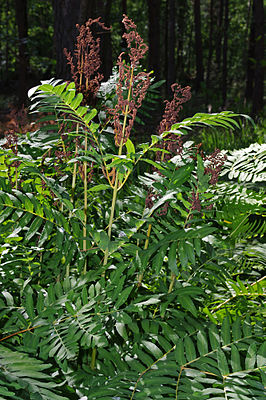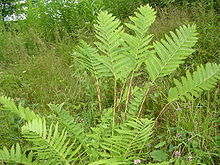Royal ferns
| Royal ferns | ||||||||||||
|---|---|---|---|---|---|---|---|---|---|---|---|---|

King fern ( Osmunda regalis ) |
||||||||||||
| Systematics | ||||||||||||
|
||||||||||||
| Scientific name of the order | ||||||||||||
| Osmundales | ||||||||||||
| Bromhead | ||||||||||||
| Scientific name of the family | ||||||||||||
| Osmundaceae | ||||||||||||
| Martynov |
The royal fern family (Osmundaceae), also called panicle fern family, is a family belonging to the class of real ferns . It is divided into three genera with a little over 20 species . They are terrestrial ferns. Due to their characteristics, the family is placed in its own Osmundales order.
features
Most representatives had a short tree-shaped trunk, which, however, is mostly hidden in the ground with today's representatives. The trunk is a leaf trace or leaf-root trunk; that is, the largest part of the trunk is formed by leaf feet and roots.
The trunk of the recent species is a siphonostele with an inner xylem. The leaves have stipules. The sporangia sit on their own sporophylls ( Osmunda cinnamomea ) or on certain sections of the trophophylls ( Osmunda regalis ). They stand on small stalks terminally on the last branches of the leaf. In Todea and a number of fossil forms, there are also sporangia attached to the underside of the leaf.

The sporangia are not combined to form sori and they lack an annulus . They are large and contain 128 to 512 spores. The sporangia wall is single-layered. At the apex of the sporangium is a group of thickened cells that cause it to rupture (sometimes called the annulus). Indusium and chaff scales are missing.
The prothallium is up to 4 centimeters long, durable and can live for several years. It is green and lives autotrophically above ground. Mycorrhiza is not detected.
The basic chromosome number is x = 22.
Occurrence
The species are distributed from the temperate to the tropical zone.
Systematics
The Osmundales are the sister group of all other leptosporangiate ferns. The family is monophyletic and is divided into three genera with around 20 species:

-
Leptopteris
C. Presl : They often form up to 1 meter high trunks, so they are " tree ferns ". There are seven species native to Australia , New Zealand , the Pacific Islands from Samoa to New Guinea, and New Caledonia . Including:
- Leptopteris hymenophylloides (A. Rich.) C. Presl , Home: New Zealand
- Leptopteris superba (Colenso) C. Presl , home: New Zealand
-
Elephant ferns ( Todea Willd. Ex Bernh. ): They often form up to 1 meter high trunks, so they are "tree ferns". There are two species found in the area of South Africa , Australia, New Zealand and New Guinea. Including:
- Todea barbara (L.) T. Moore , native to South Africa, Australia and New Zealand
- Royal ferns ( Osmunda L. ): There are 15 species. Home: mainly the northern hemisphere and subtropics ; rare in the Neotropics .
The Osmundales mediate between the Marattiales and the other leptosporangiate ferns . On the one hand, because they have been known since the Permian and had their main development in the Mesozoic ; on the other hand, morphologically, for example through the thick-walled, single sporangia, their vegetation point and the prothallium. This position was underlined by phylogenetic studies based on molecular biology.
The family name is reminiscent of the Nordic god of thunder, Thor , who is nicknamed "Osmunder".
photos
Royal fern ( Osmunda regalis ), with "bishop's staff" -shaped fern fronds
Royal fern ( Osmunda regalis ), fully developed plant
Sources and further information
literature
- Peter Sitte , Elmar Weiler , Joachim W. Kadereit , Andreas Bresinsky , Christian Körner : Textbook of botany for universities . Founded by Eduard Strasburger . 35th edition. Spektrum Akademischer Verlag, Heidelberg 2002, ISBN 3-8274-1010-X .
- Alan R. Smith, Kathleen M. Pryer, Eric Schuettpelz, Petra Korall, Harald Schneider, Paul G. Wolf: A classification for extant ferns. In: Taxon. Volume 55, No. 3, 2006, ISSN 0040-0262 , pp. 705-731, abstract, PDF file .
- Walter Zimmermann : Phylogeny of the plants. An overview of facts and problems. 2nd, completely revised edition. Gustav Fischer, Stuttgart 1959, pp. 295-300.
- Walter Erhardt among others: The big pikeperch. Encyclopedia of Plant Names . Volume 2. Verlag Eugen Ulmer, Stuttgart 2008. ISBN 978-3-8001-5406-7
Individual evidence
- ^ Andreas Bresinsky, Christian Körner, Joachim W. Kadereit, Gunther Neuhaus, Uwe Sonnewald: Textbook of Botany . Editor: Eduard Strasburger. 36th edition. Spektrum Akademischer Verlag, Heidelberg 2008, ISBN 978-3-8274-1455-7 , p. 787 .
- ↑ Smith et al .: A classification for extant ferns. 2006.
- ^ W. Zimmermann: Phylogenie der Pflanzen. 1959, p. 295.
- ↑ Kathleen M. Pryer, Eric Schuettpelz, Paul G. Wolf, Harald Schneider, Alan R. Smith, Raymond Cranfill: Phylogeny and evolution of ferns (Monilophytes) with a focus on the early leptosporangiate divergences. In: American Journal of Botany. Volume 91, No. 10, 2004, pp. 1582-1598, DOI: 10.3732 / ajb.91.10.1582 .


